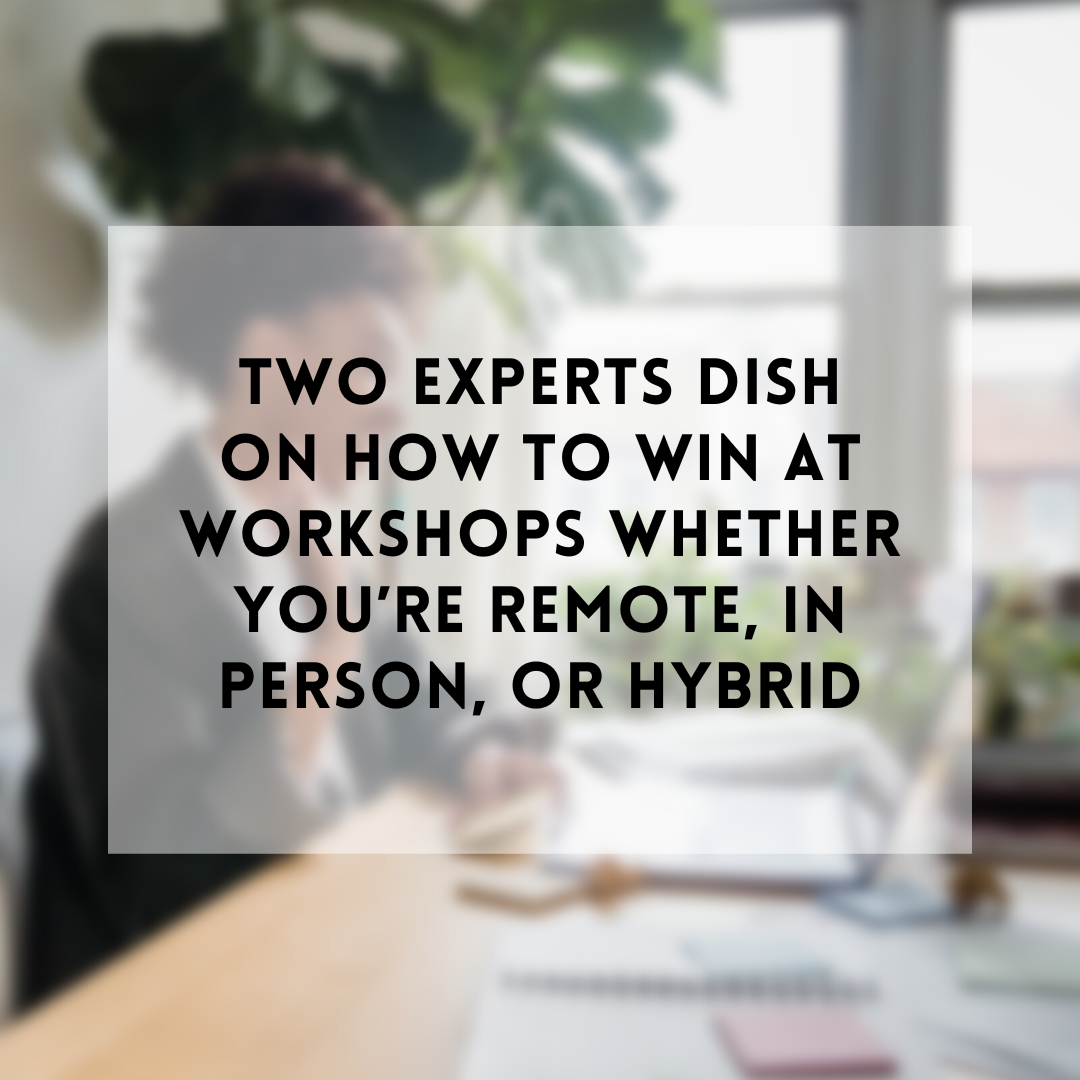Whether you’re a facilitator or a business leader, here you’ll find resources, tools and how-to guides aimed at helping your teams — and your business objectives — achieve their potential.
Stock your facilitation “go-bag” with these tools so you’re prepared for almost anything
With the return of more in-person work comes the return of more in-person workshops, and that means that we facilitators need to be prepared with the right toolkit for live gatherings. Here’s a list of the items that you might want to keep in you facilitation “go-bag” at all times.
Why workshop facilitators should opt for de-titled introductions
Did you know that most people agree de-titled introductions are preferred when kicking off workshops and meetings? Here’s why it’s so powerful, and the benefits it brings to the workshop space.
How meeting facilitators can overcome their biggest fears
You can’t make unruly or unwilling attendees disappear from meetings and workshops, but you can control how you prepare, respond and engage in real time. Doing so will make the workshop experience better for you and your participants. Here are five tips for navigating this area.
Playing Field: My go-to method for defining success
When facilitating teams embarking upon strategic work, one of the most important alignment exercises you can cover is defining what success looks like. My go-to is the playing field method, where success is defined by the participants in terms of good, better and best. Those milestones can refer to interim goals that happen en route to a home run, or different versions of success that range from most realistic to most ambitious. Here’s how to do it.
Horizons: My go-to method for wrapping up a session
You know that really long follow-up email that goes out after most meetings? This exercise aims to eliminate it by asking teams to align on what should happen next before they leave the room. Try my Time Horizons activity at the end of any strategic workshop, Design Sprint, or big meeting as a way to organize what will happen next, and who will be responsible for doing it by when.
Assets & Liabilities: My go-to method for taking inventory with teams
Assets and liabilities is an exercise I often facilitate with teams to take an inventory and drive a shared understanding of what’s working for and against the team. It’s super straightforward and something you can include in many endeavors, from strategic planning workshops and idea-generation sessions, to prototyping workshops.
How to handle derailing questions during workshops
Participants may consciously or subconsciously derail agendas and workshops. The key is not to take it personally or let it derail you. When you keep the group oriented around the agreements you made up front, it’s a lot easier to keep the train on the track. Here’s my guide for doing just that.
4 books to read this fall
With a new season comes a new list of my recommended reading! In this installment of titles that traverse my personal and professional interests, you’ll find everything from leadership and facilitation resources, to a rhyming little pig who jumps into a muddy little puddle.
Use these questions to audit your job and do more of what energizes you
If you’re feeling like it’s time to shift your career, it might be helpful to do an audit to shed light on what fills you up, the parts that you could take or leave, and the parts that feel downright dreadful. To guide the journey, consider these questions to take stock of how you spend your time and how it makes you feel.
My new favorite icebreaker for inspiring teams
Icebreakers have the power to create connection, help people feel more comfortable, and shift a group’s energy for the better. Here’s one that’s perfect for when you’re about to embark on a day of ideation and brainstorming.
Lead better customer interviews with this downloadable guide
Customer interviews are an opportunity to put a prototype in front of real people to learn what is and isn’t working so you can adjust accordingly. In order for it to work, you need to get the right information from your interviewees. This downloadable guide will help you understand how to craft questions that will get the right information flowing.
Two experts dish on how to win at workshops whether you’re remote, in person, or hybrid
Should we default to in-person meetings as pandemic restrictions ease, or should virtual meeting spaces remain as ubiquitous for their ability to increase collaboration and accessibility? To answer that question, let’s look at the pluses and minuses of remote, in-person and hybrid workshops, according to Steph Cruchon and me.
Tune up your next workshop by tuning into yourself
The thing about showing up to facilitate and guide people is that our ability to lead relies heavily on our ability to show up for ourselves first and foremost. Here are some ways facilitators can better support their minds and bodies before, during and after leading a session
3 creative sketching exercises to include in your next workshop
Engaging your team’s creative prowess is key to unlocking new ideas and uncovering solutions. To help them get there, your workshop design should include activities that encourage people to feel empowered when drawing, or suss out if an idea is worth exploring further, or get unstuck when new or different ideas just aren’t coming naturally. Here are three sketching exercises I like to use for design workshops, and that you can borrow for your next session.
The missing step you’ll want to include in your next brainstorming workshop
Most of us have participated in a brainstorm before: ideas bounce around the room, every option is captured, and the output is a big list of possibilities. So, how do you narrow down the prospects to identify the most viable ideas that will actually move the needle for your business? I came up with my own formula to tackle this challenge, which I’m breaking down here in hopes it helps your teams find clarity sooner, and identify the best solution to the problem at hand.
5 tips for living and working with ease this summer
I’ve made it my mission to bring more ease into more areas of my life this year. I’ve found that it’s difficult to meet challenges with ease at first, but once you get into the rhythm the attitude is contagious and pays dividends, both personally and professionally. Here’s what I’ve been practicing every day.
Frustrated by domineering behavior in your meetings? Here’s how to keep it in check (most of the time)
How do meeting leaders and workshop facilitators make sure teams can collaborate and produce their best work without being bulldozed by someone loud and intimidating? A bit of effort before and during a session can keep things running well and reduce the likelihood that this type of behavior will emerge from participants. And when it does, I’ve got tips for that too.
The survival guide to your first workshop
If you’re new to leading workshops, this survival guide is for you. It also has a few good reminders and nontraditional suggestions for facilitators who have been at it for a while. I know it can feel like a high-stakes game, but there are specific actions you can take to manage the experience for yourself and your participants (whether you’re leading your first or fiftieth workshop). Here are my top nine tips for a better workshop.
Why I’ve stayed a company of one
Does growth create opportunity? Absolutely. But is it the best and only way to run a business? Absolutely not. Here’s why I intentionally choose solopreneurship year after year.
Icebreakers you can steal for a better meeting (I promise)
What kicks off a day of collaborative work on a good note? How do you create a sense of camaraderie amongst colleagues or perfect strangers? The truth is simple: icebreakers. I know there’s a perception that they’re old school, or fluffy, or even cheesy. But that’s only if you aren’t using them correctly. Here are three common scenarios in which icebreakers are particularly helpful, along with specific examples so you can copy and paste them into your next session.



















